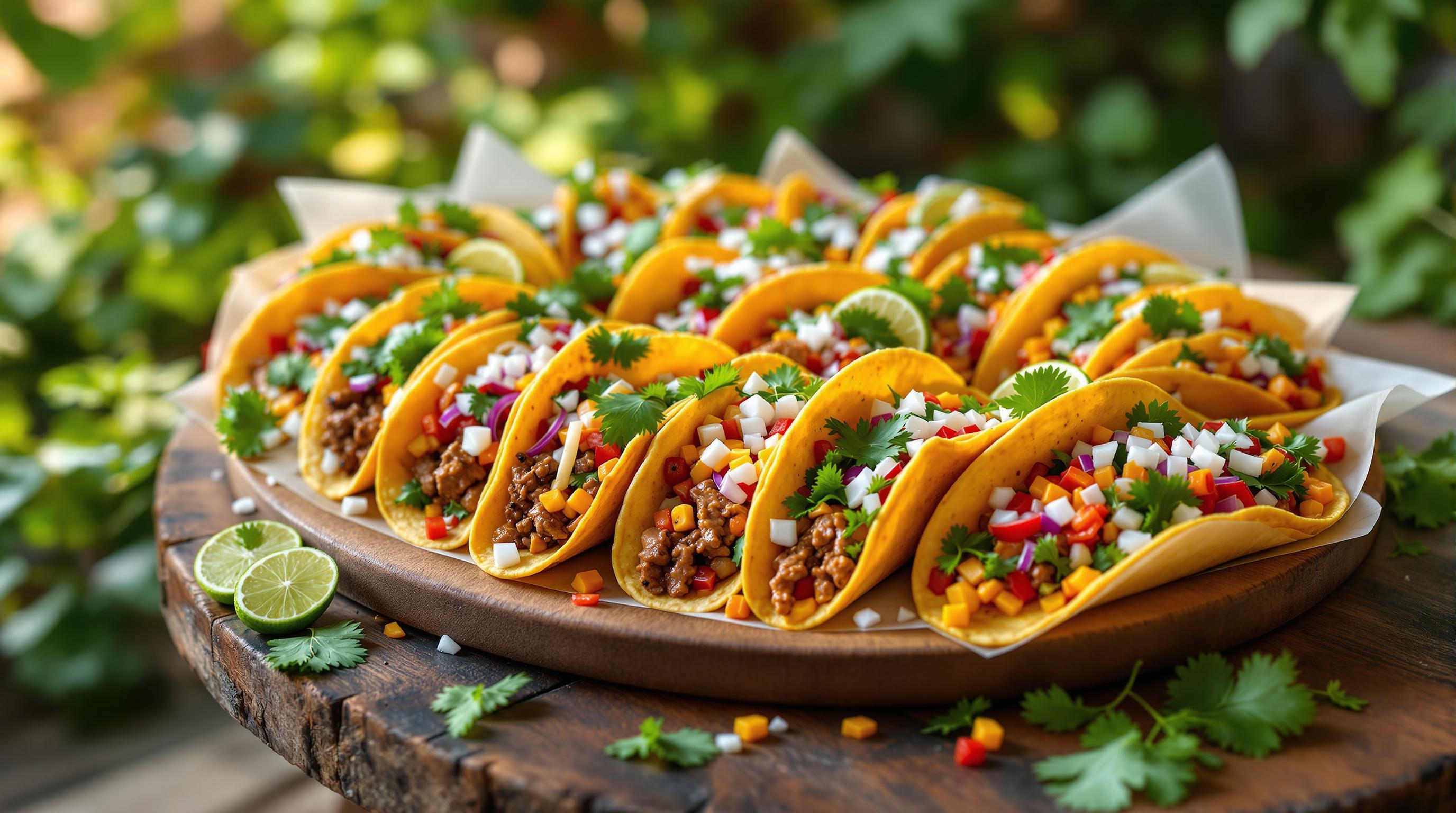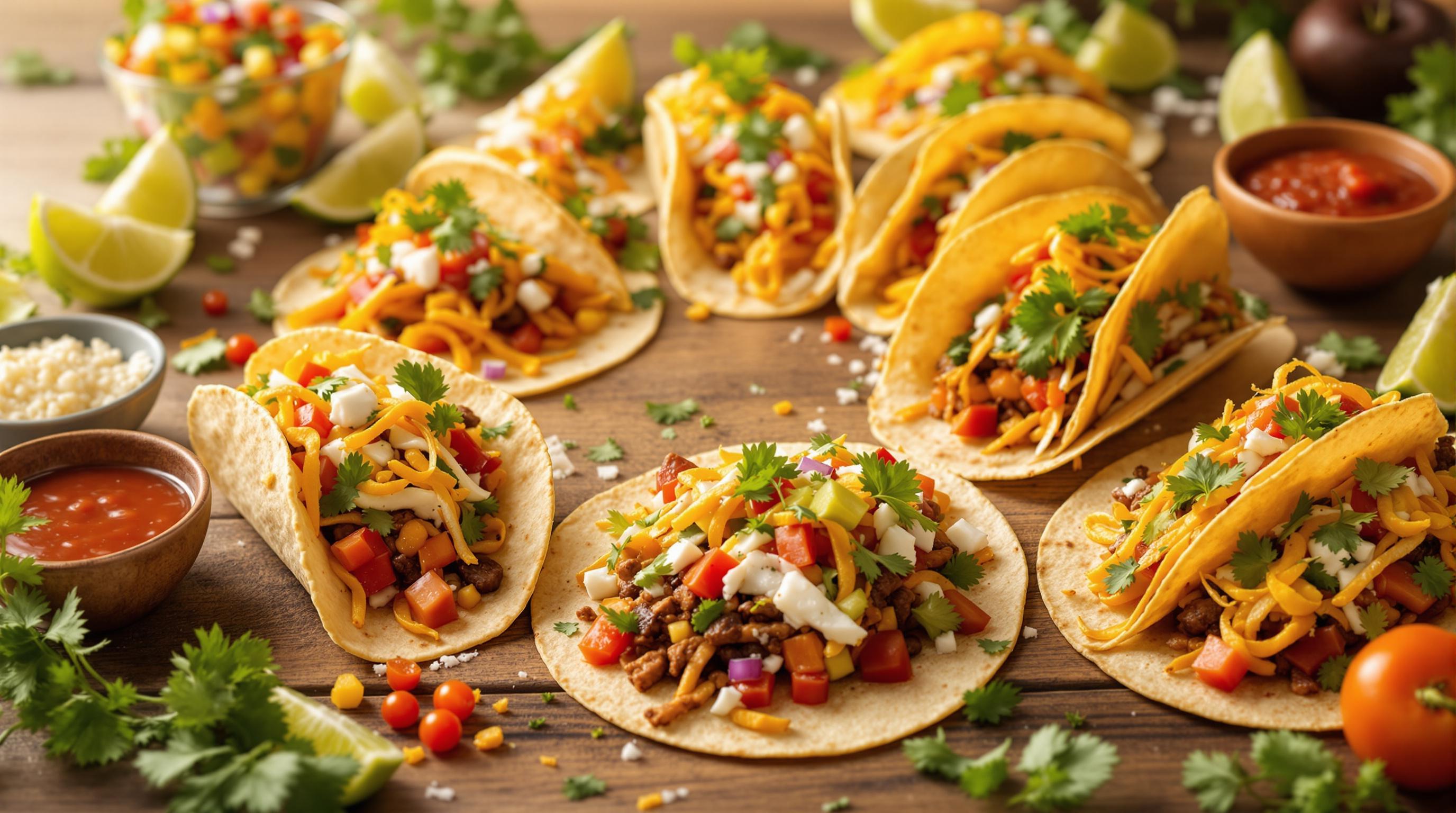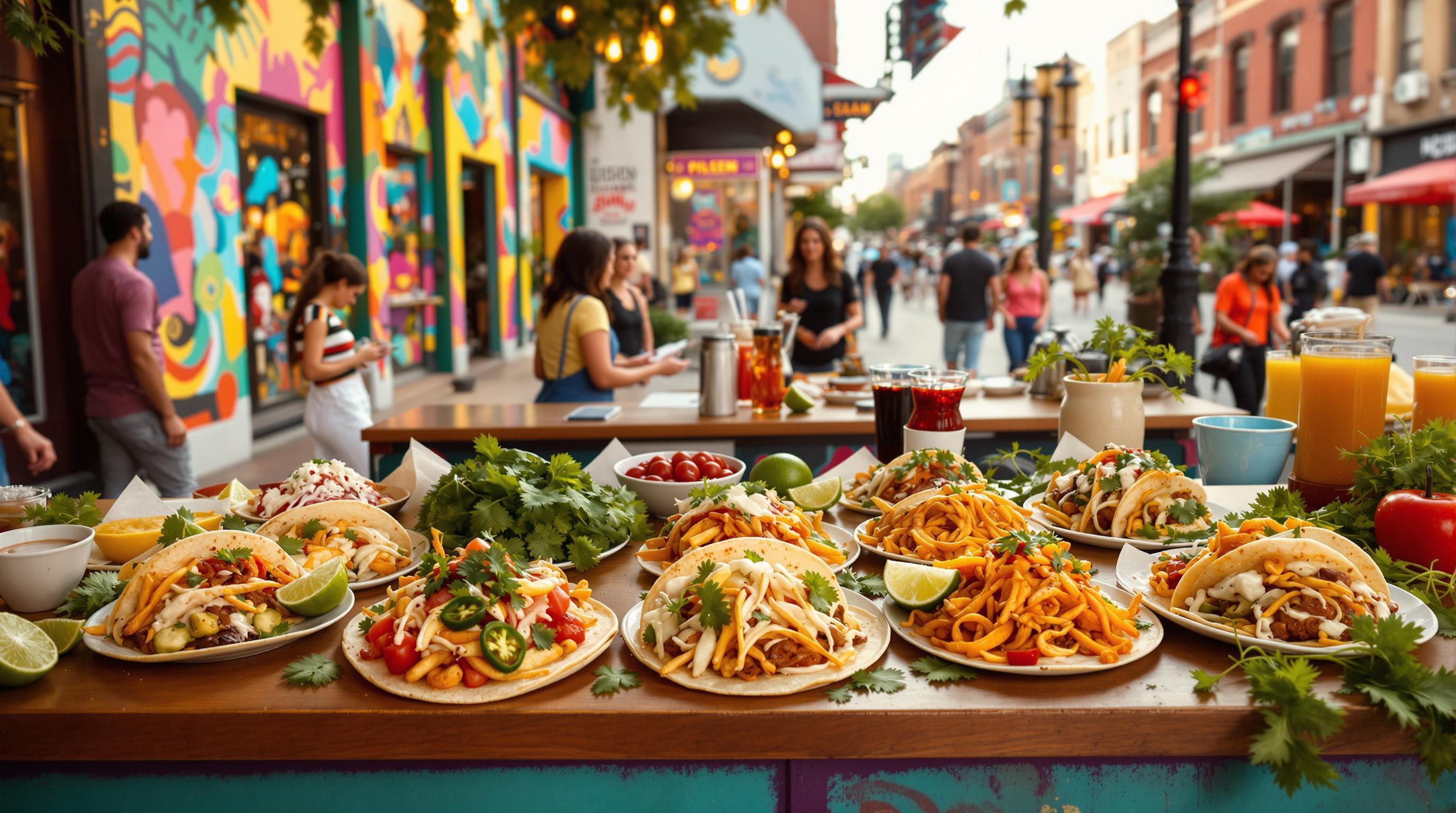Chicago has tacos for everyone, whether you want quick bites or a sit-down meal. Here's how street tacos and restaurant tacos compare:
- Street Tacos: Affordable ($2.50–$4.00), fast (5–10 min wait), and served casually with traditional fillings like al pastor or carnitas. Great for lunch breaks or late-night snacks.
- Restaurant Tacos: Higher-priced ($3.75–$8.00 or $125+ for omakase), creative fillings like beer-can chicken or seafood, and served in a relaxed, full-service setting. Perfect for special occasions or trying new flavors.
Quick Comparison
| Feature | Street Tacos | Restaurant Tacos |
|---|---|---|
| Price | $2.50–$4.00 | $3.75–$8.00 ($125+ for omakase) |
| Wait Time | 5–10 minutes | 15–30 minutes |
| Atmosphere | Casual, on-the-go | Comfortable dining |
| Tortillas | Machine-pressed | Often handmade |
| Customization | Basic toppings | Chef-driven options |
Choose street tacos for quick, traditional meals. Opt for restaurant tacos for a more refined dining experience. Both reflect Chicago's rich Mexican food culture.
Rating Every TACO In Chicago (ft. Chef Jonathan Zaragoza)
Street Tacos: Quick and Simple
Street tacos are a cornerstone of Chicago's food scene, offering a fast and flavorful way to enjoy the city's rich culinary diversity. They hold a special place in neighborhoods with strong Mexican-American roots, serving as a go-to option for a delicious meal on the move.
What Makes Street Tacos Special?
Street tacos stand out for their straightforward approach and traditional preparation. Typically served from food trucks or small stands, they focus on fresh ingredients and time-honored techniques. Vendors often specialize in specific styles or meats, from the classic al pastor to regional favorites like tacos de canasta (steamed basket tacos).
"Street tacos come from the street. It irritates the heck out of me when restaurants describe their tacos as 'street tacos' when they're being served from the comfort of a nice open air kitchen at $5 a piece. Street tacos don't have to be cheap but they aren't meant to be fancy. They serve a need and that need is something quick and delicious."
- Smokin' Chokin' and Chowing with the King [3]
This commitment to tradition is what makes Chicago's street taco vendors so beloved.
Must-Try Street Taco Vendors
Chicago's street taco scene is packed with standout options, each bringing something unique to the table:
-
Weekend Favorites
- Tacos De Canasta Rossy (4138 W. Armitage): Known for basket tacos filled with beans, potato, chicken in mole, or spicy chicharrón.
- Chavelo's Tacos (4225 W. 47th St): Serves Taco Dorado estilo Guadalajara on Friday through Sunday nights.
- Lucido's Tacos (2359 S. Hamlin): Famous for authentic tacos al pastor cooked on a trompo in Little Village.
-
Daily Spots
- Neza Kitchen's yellow food truck (3300 S. Pulaski): Offers Mexico City–style street food.
- Taco Loco (2022 S. Leavitt): Features traditional fillings with house-made salsas.
- Tacos El Torito: Known for their expertly prepared cabeza (steamed head) tacos.
Pricing and Location Breakdown
Street tacos are not only delicious but also budget-friendly. Here's a quick guide to prices and features by area:
| Area | Average Price Range | Highlights |
|---|---|---|
| Pilsen/Little Village | $2.50–$3.00 | Traditional tacos, extensive salsa bars |
| Humboldt Park | $2.75–$3.50 | Fusion options, Puerto Rican influences |
| West Side | $2.50–$3.25 | Weekend vendors, basket tacos |
| South Side | $2.50–$3.00 | Mexico City–style specialties |
Most street tacos are priced under $3.50, making them a more affordable option compared to restaurant versions. The best deals are often found in neighborhoods with a strong Mexican-American presence, where competition keeps prices low and quality high. Keep in mind that many vendors operate during specific hours or only on weekends, so double-check their schedules before heading out.
Restaurant Tacos: Full-Service Dining
Building on the quick and simple style of street tacos, restaurant tacos offer a more refined, sit-down experience. In Chicago, these restaurants elevate traditional tacos with high-quality ingredients, careful preparation, and an inviting atmosphere.
What Makes Restaurant Tacos Special?
These spots stand out with their attention to detail. Handmade tortillas serve as the perfect base for imaginative fillings and top-notch ingredients.
"All the tacos at this counter-service Logan Square spot are impressive. They're all made with chewy handmade corn tortillas, with your choice of a variety of flavorful fillings." - The Infatuation [1]
Dining options vary from relaxed settings to high-end experiences, including taco omakase, where chefs create tasting menus. These elements make Chicago's restaurant taco scene a must-try.
Top Taco Spots in Chicago
Chicago has no shortage of restaurants serving up incredible tacos. Here are some of the best:
- Birrieria Zaragoza: Famous for goat birria served with rich consommé.
- Carnitas Uruapan: Known for crispy carnitas paired with house-made salsas.
- L'Patron: Loved for its hearty portions of tender carne asada.
- Mi Tocaya Antojeria: Offers creative options like beer-can chicken and squash with corn crema.
- Antique Taco: Praised for seasonal menu items and crispy fish tacos.
- Mariscos San Pedro: Specializes in seafood tacos, including Baja-style fish and shrimp gobernador tacos.
- Cariño: A Michelin-starred destination offering an 8–12 course taco omakase for $125 per person.
- Rubi's on 18th: Once a market stall, now a full restaurant celebrated for huitlacoche tacos.
Price and Experience
Restaurant tacos blend quality ingredients with attentive service and a comfortable setting. Here's what you can expect in terms of cost and experience:
| Dining Level | Price Range | Features |
|---|---|---|
| Casual Sit-down | $3.75 – $6.00 | Table service, premium proteins |
| Upscale Casual | $5.00 – $8.00 | Creative fillings, craft drinks, bar service |
| Fine Dining | $125+ per person | Taco omakase, chef interaction |
"The taco omakase is curated based on what we as a concept feel like projecting that night. Everything else is subject to change based on ingredients and mood." [2]
sbb-itb-8621021
Direct Comparison Guide
Here’s a breakdown of the main differences between street tacos and restaurant tacos in Chicago. Use this guide to decide which option suits your taste and situation.
Comparison Chart
| Feature | Street Tacos | Restaurant Tacos |
|---|---|---|
| Average Price | $2.50 - $4.00 | $3.75 - $8.00 |
| Service Style | Counter service, often cash-only | Full table service |
| Wait Time | 5–10 minutes | 15–30 minutes |
| Atmosphere | Casual, standing or limited seating | Comfortable dining room setting |
| Tortillas | Machine-pressed, traditional | Often handmade in-house |
| Protein Options | Classic (al pastor, carne asada, pollo) | Traditional plus creative variations |
| Customization | Limited, basic toppings | Extensive, chef-driven combinations |
| Dining Experience | Quick, straightforward | Relaxed, more refined |
Taste and Preparation Differences
The way each type of taco is prepared and flavored sets them apart even further.
Street vendors, like Lucido's Tacos, stick to time-honored methods. For instance, they carve al pastor straight from the trompo, ensuring bold, authentic flavors [3]. This commitment to tradition is part of what makes street tacos so appealing.
On the other hand, restaurant tacos take these roots and elevate them with creative twists. At Mi Tocaya Antojeria in Logan Square, you’ll find inventive options like beer-can chicken or squash paired with corn crema [1]. These tacos balance tradition with artistry.
Street tacos focus on simplicity - fresh ingredients and quick preparation. Restaurant tacos, however, lean into premium ingredients and intricate presentations for a more layered flavor experience.
Both styles feature house-made salsas, but the approach differs. Street vendors stick to classic, no-frills versions, while restaurants often serve artisanal salsas designed to complement their innovative taco creations [1][3].
Making Your Choice
Go for street tacos when you want something quick and traditional. Opt for restaurant tacos if you're after a more refined, sit-down experience. Here's when each option shines:
When to Choose Street Tacos
Street tacos are perfect for a fast, no-frills meal:
- Lunch Breaks: Grab a quick bite without sacrificing flavor. For instance, 5 Rabanitos serves tacos starting at $3.75 [1].
- Late-Night Eats: Many vendors stay open late, making them great for post-event snacks.
- Affordable Meals: Enjoy authentic flavors without spending much, as many vendors keep prices low.
When to Choose Restaurant Tacos
Restaurant tacos are ideal for occasions when you want something more elevated:
- Special Events: Celebrate with creative takes on tacos in a relaxed, sit-down atmosphere.
- Dining with Friends: Share a meal with full table service, like Tacotlan’s three tacos for $16.25 [1].
- Trying New Flavors: Enjoy chef-inspired dishes with unique ingredients and combinations.
- Work Lunches: The professional setting makes restaurants a good choice for business meetings.
If you're craving speed and simplicity, street tacos are the way to go. For a more polished and inventive meal, restaurant tacos are your best bet.
Conclusion
Chicago offers a rich taco scene, blending quick, flavorful street tacos with more elevated restaurant creations. Street vendors focus on delivering fast, affordable meals, while restaurants provide a more refined dining experience with inventive takes on traditional flavors. Together, they highlight the city's deep connection to Mexican cuisine.
From tacos de canasta at food carts to unique dishes like beer-can chicken or duck carnitas at upscale spots, Chicago's taco options cater to every taste. This mix encourages locals and visitors alike to explore the entire spectrum of offerings.
Whether you're grabbing a quick bite from a street vendor or savoring a sit-down meal at a restaurant, each taco style adds something special to Chicago's food culture. Street vendors preserve classic preparation methods, while restaurants push boundaries with creative ingredients, making both essential parts of the city's culinary story.


